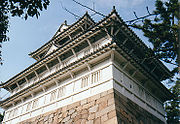
Fukuyama Domain
Encyclopedia

Edo period
The , or , is a division of Japanese history which was ruled by the shoguns of the Tokugawa family, running from 1603 to 1868. The political entity of this period was the Tokugawa shogunate....
, located in Bingo
Bingo Province
was a province of Japan on the Inland Sea side of western Honshū, comprising what is today the eastern part of Hiroshima Prefecture. It was sometimes called , with Bizen and Bitchu Provinces. Bingo bordered Bitchū, Hōki, Izumo, Iwami, and Aki Provinces....
and Bitchū
Bitchu Province
was a province of Japan on the Inland Sea side of western Honshū, in what is today western Okayama Prefecture. It was sometimes called , with Bizen and Bingo Provinces. Bitchu bordered Hōki, Mimasaka, Bizen, and Bingo Provinces....
provinces.
List of lords
- Mizuno clanMizuno clanThe was a Japanese clan which claimed descent from the Seiwa Genji branch of the Minamoto clan. In the Edo period, the Mizuno clan produced many men who were fudai daimyo serving the Tokugawa shogun, as well as countless families of hatamoto...
, 1619-1698 (FudaiFudaiwas a class of daimyo who were hereditary vassals of the Tokugawa in Edo period Japan. It was primarily the fudai who filled the ranks of the Tokugawa administration.-Origins:...
101,000 kokuKokuThe is a Japanese unit of volume, equal to ten cubic shaku. In this definition, 3.5937 koku equal one cubic metre, i.e. 1 koku is approximately 278.3 litres. The koku was originally defined as a quantity of rice, historically defined as enough rice to feed one person for one year...
)
- Katsunari
- Katsutoshi
- Katsusada
- Katsutane
- Katsumine
- TenryōTokugawa shogunateThe Tokugawa shogunate, also known as the and the , was a feudal regime of Japan established by Tokugawa Ieyasu and ruled by the shoguns of the Tokugawa family. This period is known as the Edo period and gets its name from the capital city, Edo, which is now called Tokyo, after the name was...
, 1698-1700
- Matsudaira (Okudaira) clanMatsudaira clanThe was a Japanese samurai clan that claimed descent from the Minamoto clan. It first originated in and took its name from Matsudaira village, in Mikawa Province . Over the course of its history, the clan produced many branches, most of which also centered around Mikawa Province...
, 1700-1710 (FudaiFudaiwas a class of daimyo who were hereditary vassals of the Tokugawa in Edo period Japan. It was primarily the fudai who filled the ranks of the Tokugawa administration.-Origins:...
; 100,000 kokuKokuThe is a Japanese unit of volume, equal to ten cubic shaku. In this definition, 3.5937 koku equal one cubic metre, i.e. 1 koku is approximately 278.3 litres. The koku was originally defined as a quantity of rice, historically defined as enough rice to feed one person for one year...
)
- Tadamasa
- Abe clanAbe clanThe was one of the oldest of the major Japanese clans ; and the clan retained its prominence during the Sengoku period and the Edo period. The clan's origin is said to be one of the original clans of the Yamato people; they truly gained prominence during the Heian period , and experienced a...
, 1710-1871 (FudaiFudaiwas a class of daimyo who were hereditary vassals of the Tokugawa in Edo period Japan. It was primarily the fudai who filled the ranks of the Tokugawa administration.-Origins:...
; 100,000->110,000 kokuKokuThe is a Japanese unit of volume, equal to ten cubic shaku. In this definition, 3.5937 koku equal one cubic metre, i.e. 1 koku is approximately 278.3 litres. The koku was originally defined as a quantity of rice, historically defined as enough rice to feed one person for one year...
)
- Masakuni
- Masayoshi
- Masasuke
- Masatomo
- Masakiyo
- Masayasu
- MasahiroAbe Masahirowas the chief senior councillor in the Japanese government at the time of the arrival of Commodore Matthew Perry. Against the shogun's wishes, and the wishes of many other government officials, he worked to open Japan to the West, signing the Convention of Kanagawa in 1854, and other unequal...
- Masanori
- Masakata
- Masatake

